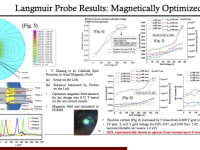
Currently, air-breathing electric propulsion ramjet configurations are considered worldwide. However, configurations with air scoops suffer from significant momentum losses due to air collimation and drag. One idea that was proposed a few years ago and requires further development is a direct scramjet configuration that can significantly reduce drag. In this case, full ionization of atmospheric molecules is required. A new mode of operation for air-breathing thruster was discovered. The research focuses on the so-called self-neutralizing air-breathing plasma thruster (SABPT). Ion production is controlled by electron energy. Primary testing shows that both positive and negative ions can be produced thus providing conditions for SABPT.
Recently, there has been a growing interest in the research and development of propulsion devices for very low earth orbits. These devices would typically function with a thrust level of about 90mN-90N to counteract drag level (60 mN- 60N) in 80-260 km altitude ranges. The air-breathing plasma thruster would operate by in situ air propellant ionization to produce thrust in these altitudes. This device brings advantages such as low launch cost, payload reduction by eliminating propellant tanks, effective utilization of space resources, and enhanced imaging capability. However, there are some physical and operational challenges, such as developing an optimum approach to air ionization in a rarefied gas environment and building collimator-less designs (collimators introduce additional drag). Recently it was proposed to use a scramjet-type configuration without air collimation. In a scramjet-type configuration, the incoming air is at a high speed that is not deaccelerated, unlike with a ramjet. This configuration could potentially eliminate the complexity of using a collimator (which increases the pressure and reduces the velocity) and reduces drag.
Typically, an air-breathing plasma thruster would require an external neutralizer to inject electrons for ion beam neutralization. Whereas we propose a design (SABPT) that utilizes positive and negative ions to achieve beam neutralization. Earlier, it was shown theoretically that the SABPT has the potential to achieve self-neutralization by operating in a high to low electron energy mode operation. The ions generated inside the thruster could be extracted using electrodes with alternating potential (based on the polarity of the ion charge to extract). As a result, the charge densities would cancel out to achieve a self-neutralized beam. To achieve the design requirements, the electron source inside the SABPT would need to have prominent control over the electron energy for the generation of positive and negative ions. Additionally, its operation would require stability in harsh air plasma environments. To that end, we propose a low-power vacuum arc electron source as a potential electron source to fulfill the SABPT design requirements.
Video
-
Awards
-
 2023 Top 10 Most Popular
2023 Top 10 Most Popular
Like this entry?
-
About the Entrant
- Name:Anmol Taploo
- Type of entry:teamTeam members:
- Michael Keidar
- Li Lin
- Vikas Soni
- Software used for this entry:COMSOL, FEMM, Solid Works and Ansys Maxwell
- Patent status:pending








